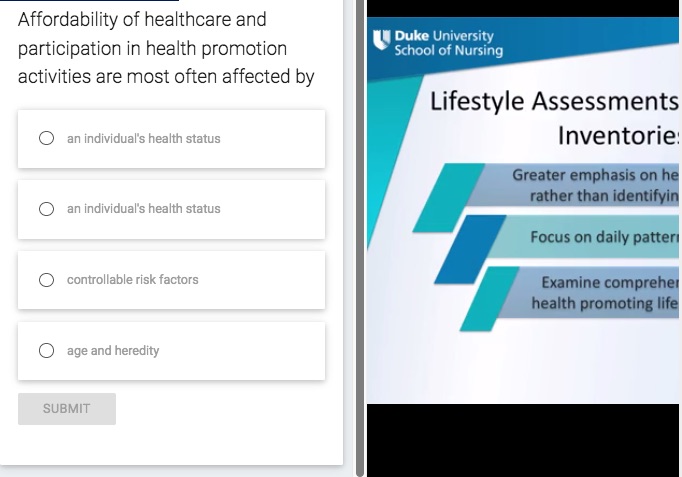The Center for Instructional Technology (CIT) partnered with the Duke University School of Nursing (DUSON) to redesign and implement a cross-cultural perspective to N502: Health Promotion and Disease Prevention, a graduate online course. The online course included students enrolled through Duke in Durham and Duke in China at Duke Kunshan University. The project team proposed a set of recommendations for a more interactive, student-centered, mobile-friendly course that included cross-cultural and global components.
Engaging Lecture Videos
Modular, mobile-friendly content: Working with the Duke Office of Information Technology (OIT) video team and Queen Utley-Smith, Associate Professor, Duke School of Nursing, we developed 11 new professional and personalized videos. We created modular content, shortening lecture videos from over an hour to approximately 20 – 25 minutes each. Longer videos were offered in multiple parts.

Embedded Videos with Warpwire
Weekly lectures were recorded using a video recording kit provided by OIT. We embedded the videos in the weekly lessons page using Warpwire, which makes it easier for students to access course content on mobile devices. The redesign included new slide decks and graphics for the lectures.

Video with Animation
The course overview video included an animation to visually tell a compelling story central to the importance of the course’s theme on health promotion and disease prevention.

Interactive Video with Playposit
We piloted the integration of Playposit, adding in-video quiz questions in the form of multiple-choice questions to some of the lecture videos. Playposit was used as a tool to reinforce students’ learning by building in practice time and making for a more engaging learning experience.

Integration of Global Components
Video Captured in China
Utley-Smith traveled to China to Duke Kunshan University to interview practicing health practitioners on health promotion activities to add a more cross-cultural presence by integrating this video content into the course.

The instructor captured her own video in China, using video equipment available at the Duke Link. More information is available on equipment available to faculty for loan. OIT provided video training onsite at Duke. The video kit included an external hard drive and all the necessary connections, but a tripod was provided separately by OIT. A new video captured in China, “An example of global health community-based health promotion activities to combat non-communicable diseases,” was added to the course to enhance the cross-cultural learning experience for students at Duke and at Duke Kunshan.
Learner-centered Design
Our visual redesign included: (1) designing course templates and banners and redesigning the course overview “home” page (2) streamlined navigation (3) visual redesign of the 12 lesson modules and the “Weekly Lessons” landing page, and (4) a Start Here page with embedded video, including a course orientation tour video.


Designing Global Online Courses: What to Consider
For faculty who plan to take on a global online course redesign project in the future, here are a few key points to consider:
- Video time commitment: Faculty will need to build in practice time and plan on more than one take of a video.
- Creating modular content: In addition to the time needed to record lecture videos, storyboarding content takes time. The lecture storyboarding can be a challenge when trying to condense material to create modular content, but storyboarding can help an instructor be more efficient at condensing a large amount of content.
- Video capture at a remote site: An instructor planning to travel internationally to capture video, but trained at Duke on using the equipment, needs to be aware the international environment will be different and it might not be possible to capture video that closely matches the way faculty were set up and trained at Duke. (It is also beneficial to have video help at the remote site.)
- Global learner perspective: Consider how teaching methods and techniques, communication, and technology might impact international learners. Create opportunities for synchronous interactions, using WebEx or other communication tools.
- Pilot: Always pilot the initial redesign and plan to make changes and improvements in the next offering.

